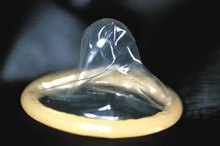Causes of Brown and Yellow Vaginal Discharge
Many women have a small amount of vaginal discharge, especially during their childbearing years. This discharge is usually a clear, white or slightly yellow fluid secreted by glands in the cervix and vaginal lining.
If you are experiencing serious medical symptoms, seek emergency treatment immediately.
An increase in the amount of discharge and a change in color could indicate an infection or another problem in the reproductive tract. Talk with your doctor if you experience any significant change in the amount or color of vaginal discharge.
Common and Usually Harmless
The cause of yellowish or brown vaginal discharge is often a common and usually harmless issue. Occasional spotting between periods might have this appearance and can be normal, especially if you're taking low-dose birth control pills or are using an intrauterine device (IUD).
Brownish discharge may also occur after sexual intercourse if the vaginal lining bleeds lightly due to irritation. This is particularly likely after menopause, when the vaginal lining thins. A woman in the first few weeks of pregnancy might have some brown discharge, or spotting, at about the time of her expected period as the embryo implants in the uterus. The discharge is caused by slight bleeding from the uterine lining and usually subsides in a day or two.
- The cause of yellowish or brown vaginal discharge is often a common and usually harmless issue.
- The discharge is caused by slight bleeding from the uterine lining and usually subsides in a day or two.
Bacterial Vaginosis
What Are the Symptoms of Trichomoniasis & Bacterial Vaginosis?
Learn More
An array of usually harmless bacteria are normally present in the vagina.
If something upsets the balance of these bacteria, potentially harmful bacteria can overgrow and cause symptoms. **A thin, malodorous, white to yellow or brownish discharge can occur along with possible itching or burning, although these symptoms are not common.
The cause of this condition, called bacterial vaginosis, isn't fully understood. ** However, having a new sex partner, douching and not using condoms are associated with an increased risk.
- An array of usually harmless bacteria are normally present in the vagina.
- A thin, malodorous, white to yellow or brownish discharge can occur along with possible itching or burning, although these symptoms are not common.
Yeast Infection
An abnormal vaginal discharge could result from an overgrowth of yeast. Although small amounts of yeast may normally exist in the vagina, overgrowth can cause a thick, yellow-tinged vaginal discharge along with inflammation, burning and itching 8. A March 2015 article in the "Journal of Obstetrics and Gynaecology Canada" reports that 75 percent of women experience a vaginal yeast infection at least once. Over-the-counter antifungal medication is generally effective, such as clotrimazole (Gyne-Lotrimin) and miconazole (Monistat). However, some women experience recurrent yeast infections and require additional treatment.
Sexually Transmitted Infections
Herbal Treatment for Chlamydia
Learn More
Some types of bacterial infections that may cause yellow or brown discharge are sexually transmitted, including chlamydia and gonorrhea. **A study published in the August 2000 issue of "Sexually Transmitted Infections" found that about 22 percent of 319 Indian women with abnormal vaginal discharge had a sexually transmitted infection 5.
** However, many women with a sexually transmitted infection do not experience a noticeable change in their vaginal discharge 5. Trichomoniasis is another type of sexually transmitted infection caused by a single-celled microorganism called Trichomonas vaginalis.
This infection may cause a white to yellowish-green vaginal discharge. The discharge may have an unpleasant odor and be accompanied by itching and burning, although some women do not experience these symptoms.
- Some types of bacterial infections that may cause yellow or brown discharge are sexually transmitted, including chlamydia and gonorrhea.
Possible Serious Problems
**In some cases, a yellow or brown vaginal discharge could indicate a serious problem.
** Brown vaginal discharge or bleeding might develop in a woman with uterine or cervical cancer, although sometimes there aren't any symptoms, especially in the early stages.
A miscarriage may cause a prolonged brown discharge as the initial bleeding subsides. Problems with the placenta during pregnancy can also cause brownish spotting or bleeding, which should be checked immediately by a doctor 1.
- In some cases, a yellow or brown vaginal discharge could indicate a serious problem.
- Brown vaginal discharge or bleeding might develop in a woman with uterine or cervical cancer, although sometimes there aren't any symptoms, especially in the early stages.
Cautionary Note
Although brown and yellow vaginal discharge often does not indicate a serious problem, it should not be ignored if it persists, recurs or is accompanied by other symptoms.
Many conditions -- both normal and abnormal -- require a medical professional to make a accurate diagnosis. Seek immediate medical attention if you might be pregnant and experience unusual vaginal discharge or bleeding.
Reviewed by: Tina M. St. John, M.D.
- Although brown and yellow vaginal discharge often does not indicate a serious problem, it should not be ignored if it persists, recurs or is accompanied by other symptoms.
- Seek immediate medical attention if you might be pregnant and experience unusual vaginal discharge or bleeding.
Related Articles
References
- Bleeding During Pregnancy: A Comprehensive Guide; Eyal K. Sheiner
- American College of Obstetricians and Gynecologists: Vaginitis
- Canadian Family Physician: Vaginal Discharge -- An Approach to Diagnosis and Management
- Centers for Disease Control and Prevention: 2015 Sexually Transmitted Diseases Treatment Guidelines: Bacterial Vaginosis
- Sexually Transmitted Infections: Syndromic Management of Vaginal Discharge Among Women in a Reproductive Health Clinic in India
- Centers for Disease Control and Prevention: Uterine Cancer
- Centers for Disease Control and Prevention: Cervical Cancer
- Merck Manual Professional Version: Vaginal Itching and Discharge
- Journal of Obstetrics and Gynaecology Canada: Vulvovaginitis: Screening for and Management of Trichomoniasis, Vulvovaginal Candidiasis, and Bacterial Vaginosis
- Miller EA, Beasley DE, Dunn RR, Archie EA. Lactobacilli Dominance and Vaginal pH: Why Is the Human Vaginal Microbiome Unique? Front Microbiol. 2016;7:1936. doi:10.3389/fmicb.2016.01936
- Godha K, Tucker KM, Biehl C, Archer DF, Mirkin S. Human vaginal pH and microbiota: an update. Gynecol Endocrinol. 2018;34(6):451-455. doi:10.1080/09513590.2017.1407753
- Amabebe E, Anumba DOC. The Vaginal Microenvironment: The Physiologic Role of Lactobacilli. Front Med. 2018;5:181. doi:10.3389/fmed.2018.00181
- Watson CJ, Grando D, Garland SM, Myers S, Fairley CK, Pirotta M. Premenstrual vaginal colonization of Candida and symptoms of vaginitis. J Med Microbiol. 2012;61(Pt 11):1580-1583. doi:10.1099/jmm.0.044578-0
- Paladine HL, Desai UA. Vaginitis: Diagnosis and Treatment. Am Fam Physician. 2018;97(5):321-329.
- Martin Lopez JE. Candidiasis (vulvovaginal). BMJ Clin Evid. 2015:0815
- Hay P. Bacterial vaginosis. F1000Res. 2017;6:1761. doi:10.12688/f1000research.11417.1
- Paladine HL, Desai UA. Vaginitis: Diagnosis and Treatment. Am Fam Physician. 2018;97(5):321-329.
- Qin F, Wang Q, Zhang C, et al. Efficacy of antifungal drugs in the treatment of vulvovaginal candidiasis: a Bayesian network meta-analysis. Infect Drug Resist. 2018;11:1893-1901. doi:10.2147/IDR.S175588
- Chavoustie SE, Jacobs M, Reisman HA, et al. Metronidazole vaginal gel 1.3% in the treatment of bacterial vaginosis: a dose-ranging study. J Low Genit Tract Dis. 2015;19(2):129-134. doi:10.1097/LGT.0000000000000062
Writer Bio
Joanne Marie began writing professionally in 1981. Her work has appeared in health, medical and scientific publications such as Endocrinology and Journal of Cell Biology. She has also published in hobbyist offerings such as The Hobstarand The Bagpiper. Marie is a certified master gardener and has a Ph.D. in anatomy from Temple University School of Medicine.









